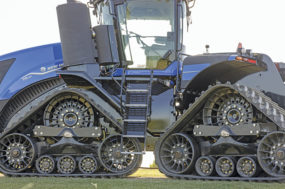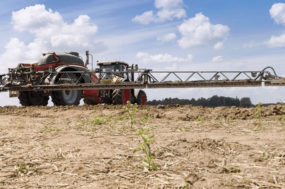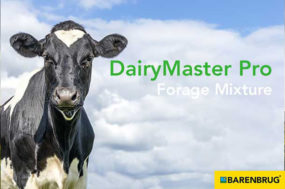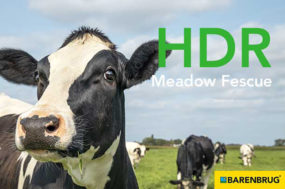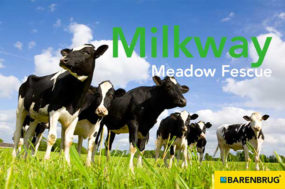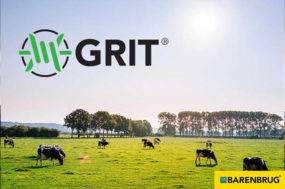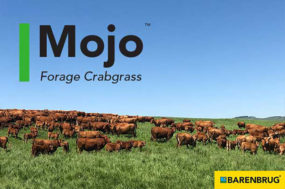“We should remember hay is the highest quality the day that we cut it,” says Dan Undersander, forage agronomist at the University of Wisconsin – Madison. “We’re simply trying to preserve that quality through the harvesting process. The higher the quality, the more animal performance we’ll get in terms of weight gain or milk production.”
In his years of experience, Undersander said the cutting height of your forage should be the first step in your management system, and I couldn’t agree more.
The cutting height is really important and, from the perspective of quality, getting that cutterbar off the ground by 3 or 4 inches – whatever it may be depending on the grass – is pretty important. When you’re going to select a mower conditioner, you need to ask these questions: How high can this thing cut?
How high can I get the cutterbar off the ground? In doing that, also ask if there is a way to get it off the ground without tilting the head back. We have found that having the head tilted forward on the mower conditioner will result in a cleaner cut, though many manufacturers’ machinery requires you to tilt the head back.
Undersander recommends cutting legume crops at 3 inches, cool-season grass at 4 inches and land grass or millet up to 6 inches.
“The reason being, the grass stores energy in the base of the stem and if we cut too short, then it won’t regrow as fast and it won’t yield as much for the year,” Undersander says. “Alfalfa, on the other hand, and clover store their energy in the root, and you can cut them shorter because they will regrow from those carbohydrates in the roots.”
The reason Undersander recommends 3 inches for alfalfa is twofold. While cutting lower results in more tonnage, it’s all stem and low-quality forage. The second reason is that the lower the cut, the more soil that can be picked up (particularly with disc mowers) when the soil is dry.
“We have seen samples that come through the forage testing lab that oftentimes run as much as 15 to 18 percent ash,” Undersander says. “Inside the grass or alfalfa, we have something close to around 6 percent ash. So that means these people have picked up 10 percent dirt. What we do know is that beef cattle don’t gain weight eating dirt, and cows don’t milk eating dirt.”
I know when I was a kid, we used to basically scalp the ground when mowing. When I look at it now, from the perspective of quality, getting that cutterbar up off the ground is essential.
Undersander says keeping the total ash content of forage below 10 percent is a doable goal that’s essential to nutrition. With this 10 percent goal, he’s allotting for an estimated 6 to 8 percent of ash inside the plant and 1 or 2 percent dirt.
“We can’t get away from dirt, but we can try to keep it to a minimum,” Undersander says. “What we do find is that the more dirt you have in that sample – remember that each 1 percent of ash reduces the TDN [total digestible nutrients] content by 1 percent because each 1 percent ash is 1 percent less nutrients and 1 percent less minerals.”
According to Undersander, it’s important to remember that the levels of starch and sugar in the forage are 100 percent digestible at harvest. No matter what type of forage you’re growing, the first 15 percent of moisture should be dried off as quickly as possible in order to keep these levels of starch and sugar high for the animals. The faster the drydown, the faster you shut down the respiration, and the more starches and sugars can be preserved.
“The way to get hay to dry as quickly as possible is first to properly condition the hay and then to make a wide swath,” Undersander says. “When we are conditioning the hay, we can use either a flail conditioner for grassy crops or a roller conditioner for legume crops.
We use the roller conditioner for legumes because we have less leaf loss, and we want to maintain that quality of the leaves and keep it in the final product that we bale.”
With either type of conditioner, it’s important to properly adjust the head to help ensure adequate conditioning occurs and adjust into a wide swath covering 70 to 80 percent of the cut area. Going to a wide-swath conditioner just makes more sense because you can expose more of the crop to the sun. Why not just let Mother Nature do her work to dry out the hay?
Creating baleage is an additional option that can provide quality hay with less drydown time.
“If we’re making hay, we need three to five days for the drying process to get good-quality hay made, but if we’re making baleage, we can get in there and put it up in one or two days and have even higher-quality forage than if we’d put that dry hay up because we’ll have the reduced leaf loss,” Undersander says. “So baleage can be advantageous in terms of letting us harvest in a time when quality is high but maybe rain is on the horizon, and then you still end up with higher-quality forage for the animals we’re trying to feed.” ![]()
Josh Vrieze is a product manager with Vermeer Corporation. Email Josh Vrieze.
Haying field tips
Cutting height
- Legumes – 3 inches
- Cool-season grasses – 4 inches
- Land grass or millet – 6 inches
Ash content
Keep total ash content at 10 percent or below, which allows for:
- 6 to 8 percent of ash inside the plant
- 1 to 2 percent of ash from the dirt
More tips and tricks
- 15 percent of moisture should be dried off as quickly as possible to preserve starches and sugars.
- Adjust for a wide swath (covering 70 to 80 percent of the cut area) when mowing for a faster drydown.
- Use a flail mower conditioner for grassy crops.
- Use a roller mower conditioner for legumes.
- Adjust mower head to tilt forward (not backward) for the cleanest cut.
Questions to ask your hay equipment dealer when purchasing a mower conditioner
- How high can it cut?
- How high does the cutterbar come off the ground?
- Is there a way to get the cutterbar off the ground without tilting the head back?



